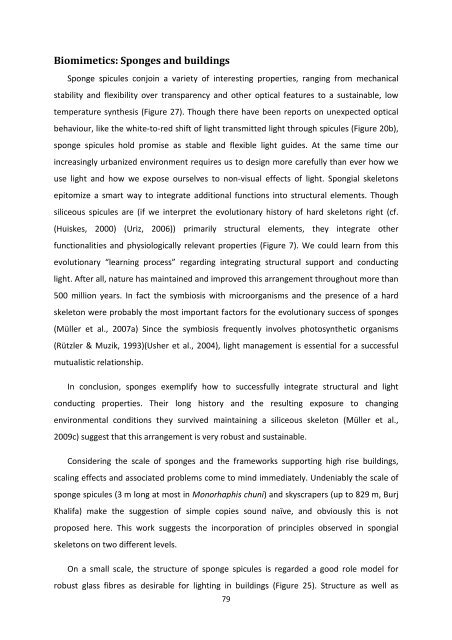MASTER THESIS Biomimetic potential of sponge ... - IAP/TU Wien
MASTER THESIS Biomimetic potential of sponge ... - IAP/TU Wien
MASTER THESIS Biomimetic potential of sponge ... - IAP/TU Wien
You also want an ePaper? Increase the reach of your titles
YUMPU automatically turns print PDFs into web optimized ePapers that Google loves.
<strong>Biomimetic</strong>s: Sponges and buildings<br />
Sponge spicules conjoin a variety <strong>of</strong> interesting properties, ranging from mechanical<br />
stability and flexibility over transparency and other optical features to a sustainable, low<br />
temperature synthesis (Figure 27). Though there have been reports on unexpected optical<br />
behaviour, like the white-to-red shift <strong>of</strong> light transmitted light through spicules (Figure 20b),<br />
<strong>sponge</strong> spicules hold promise as stable and flexible light guides. At the same time our<br />
increasingly urbanized environment requires us to design more carefully than ever how we<br />
use light and how we expose ourselves to non-visual effects <strong>of</strong> light. Spongial skeletons<br />
epitomize a smart way to integrate additional functions into structural elements. Though<br />
siliceous spicules are (if we interpret the evolutionary history <strong>of</strong> hard skeletons right (cf.<br />
(Huiskes, 2000) (Uriz, 2006)) primarily structural elements, they integrate other<br />
functionalities and physiologically relevant properties (Figure 7). We could learn from this<br />
evolutionary “learning process” regarding integrating structural support and conducting<br />
light. After all, nature has maintained and improved this arrangement throughout more than<br />
500 million years. In fact the symbiosis with microorganisms and the presence <strong>of</strong> a hard<br />
skeleton were probably the most important factors for the evolutionary success <strong>of</strong> <strong>sponge</strong>s<br />
(Müller et al., 2007a) Since the symbiosis frequently involves photosynthetic organisms<br />
(Rützler & Muzik, 1993)(Usher et al., 2004), light management is essential for a successful<br />
mutualistic relationship.<br />
In conclusion, <strong>sponge</strong>s exemplify how to successfully integrate structural and light<br />
conducting properties. Their long history and the resulting exposure to changing<br />
environmental conditions they survived maintaining a siliceous skeleton (Müller et al.,<br />
2009c) suggest that this arrangement is very robust and sustainable.<br />
Considering the scale <strong>of</strong> <strong>sponge</strong>s and the frameworks supporting high rise buildings,<br />
scaling effects and associated problems come to mind immediately. Undeniably the scale <strong>of</strong><br />
<strong>sponge</strong> spicules (3 m long at most in Monorhaphis chuni) and skyscrapers (up to 829 m, Burj<br />
Khalifa) make the suggestion <strong>of</strong> simple copies sound naïve, and obviously this is not<br />
proposed here. This work suggests the incorporation <strong>of</strong> principles observed in spongial<br />
skeletons on two different levels.<br />
On a small scale, the structure <strong>of</strong> <strong>sponge</strong> spicules is regarded a good role model for<br />
robust glass fibres as desirable for lighting in buildings (Figure 25). Structure as well as<br />
79

















